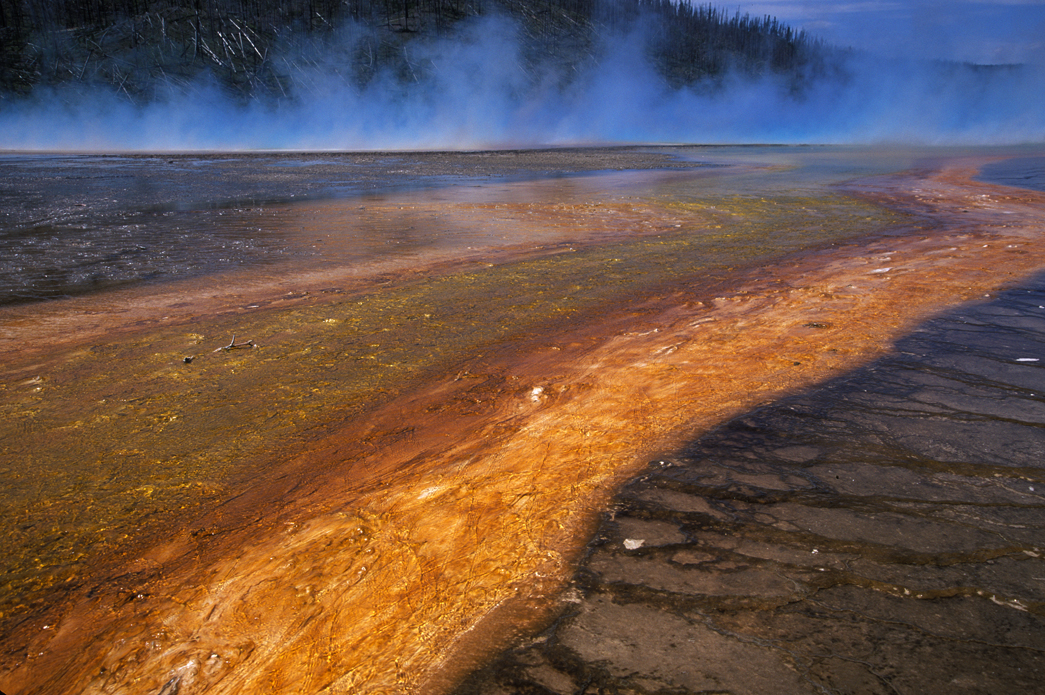
by Judy Lehmberg – photos available at www.vernelehmberg.com

Most everyone has heard of DNA, the chemical our genes are made of. It has become better known in the last 20 to 30 years as we have learned how to move genes from one organism to another (to create genetically engineered crops, and to make it possible to treat genetic disorders like cystic fibrosis), the human genome project has been completed, and DNA fingerprinting is now routine. Our newer knowledge of DNA is changing crop science, medicine, and a myriad of other things, some of which we haven’t even thought of yet. So you say “That’s nice but what in the world does it have to do with Yellowstone National Park?” And the answer is everything. None of the above would have been possible if it weren’t for the bacteria that lives in one or two hot pools along Firehole Lake Drive in between the Upper and Lower Geyser Basins. In the late 1960s Thomas Brock and Hudson Freeze of Indiana University found a new species of thermophilic (heat loving) bacteria there. It can live at temperatures between 122° and 179° F. That is pretty neat, but what is even neater is that all of Thermus aquaticus’ enzymes can survive at those temperatures.
Let me give you an example of why that is important. Suppose you are a detective assigned to the case when O.J. Simpson was accused of killing his former wife and her boyfriend. You find a small amount of blood at the crime scene you believe may be the murderers blood. The murderers DNA is in that blood but you don’t have enough of it to compare to a sample from O.J. Simpson. So you put the small amount of blood into a PCR machine and a few hours later you have millions of copies of DNA that can be compared to O.J. Simpson’s DNA. That PCR machine is what makes DNA fingerprinting and all of the other DNA technologies possible because it takes very small samples of DNA and makes literally millions of copies in a short time. (I know O.J. Simpson was found not guilty but I also know several DNA samples from the crime scene were his. I guess the lawyers couldn’t prove he was there, but his DNA was.)

Once scientists started collecting DNA and cutting it into smaller pieces they realized they needed to make many copies of it to do anything worthwhile. So they put an enzyme, human DNA polymerase, in a test tube with the DNA they wanted to copy and the polymerase made TWO copies. To make more copies the DNA had to be heated to get the two strands to separate. In a test tube the only way to separate DNA is to heat it up. The DNA will separate at high temperatures but the human DNA polymerase was destroyed by heat so more had to be added. DNA polymerase is super expensive so that was note a viable solution. Kary Mullis, then at Cetus Corporation, had an epiphany when he realized Thermus aquaticus DNA polymerase could be used in place of the human DNA polymerase because it wouldn’t be destroyed by the high temperatures needed to separate DNA in preparation for making more copies. His ideas were so important he won the Nobel Prize.

Since Brock found Thermus aquatics many other thermophilic species of bacteria have been discovered in Yellowstone’s hot pools. These species have not only given us a more expanded view of where life can survive, and even thrive, we have also discovered many uses for the bacteria’s heat resistant enzymes, such as cleaning up chemical waste dumps, decomposing rubber tires, biorefining (converting cellulose from corn and wood into sugars, fuel, along with many other chemicals used to make nylon, food, pharmaceuticals, antifreeze, polyesters, latex) and many other industrially important chemicals.

For those of you that just don’t get into the whole bacteria thing here is a male grizzly on an elk carcass in the meadow across from Obsidian Cliffs from yesterday morning. I thought the way he was lifting up the elk’s leg was kind of unusual.







Thank you Deby and Barbara! Barbara I wish I was still teaching and had your teenagers in my class. It is too bad we don’t have more decent teachers. Biology is a fascinating subject that is hard to make boring, well except for maybe the Kreb’s Cycle. Say that to your kids and watch them roll their eyes.
Judy that was very interesting about the DNA. I read it to my family as we drove to Grand Tetons. My teenagers wish all biology teachers were as interesting as your stories and information. 🙂 We also saw that grizzly at the elk.
I love this whole thing about the DNA – who would have guessed that the technology came from Yellowstone, yet it takes so long to get the results back on our animals. I heard that the park gets free testing! But, that image of the bear lifting the leg is amazing. Looks like a goofy old bear that has a sense of humor and likes to have fun.